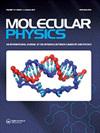Pt-embedded Janus WSTe monolayer for adsorption and detection of XO 2 (X = C, N and S) gases: a first-principles study
IF 1.8
4区 化学
Q4 CHEMISTRY, PHYSICAL
引用次数: 0
Abstract
AbstractFor sensing XO2 (X = C, N and S) gas species, this work purposes Pt-embedded WSTe monolayer, and using first-principles theory uncovers related gas adsorption properties and sensing mechanism. Results indicate that Pt-embedding is more energy favourable by replacing Te atom of the Janus WSTe monolayer with the formation energy of −1.78 eV, narrowing the bandgap to 0.926 eV. Besides, the Pt-WSTe monolayer performs weak physisorption upon CO2 with adsorption energy (Ead) of −0.17 eV, while strong chemisorption upon NO2 and SO2 with Ead of −1.43 and −1.17 eV, respectively. The analysis of electronic property uncovers the sensing potential of Pt-WSTe monolayer as a resistance-type NO2 or SO2 gas sensor with higher sensing response upon SO2, and the analysis of work function (WF) uncovers the sensing potential of Pt-WSTe monolayer as a WF-type NO2 or SO2 gas sensor with higher sensing response upon NO2. We are hopeful that the findings in this work can help to explore the possible application of Pt-WSTe monolayer in the gas sensing field and also to make some other explorations on Janus WSTe-based material for gas detections.KEYWORDS: Pt-WSTe monolayerfirst-principles theoryXO2gas sensing Disclosure statementNo potential conflict of interest was reported by the author(s).Additional informationFundingThis work is supported by National Natural Science Foundation of China (No. 52207175).铂包埋Janus WSTe单层吸附和检测XO 2 (X = C, N和S)气体:第一性原理研究
摘要为了对XO2 (X = C, N和S)气体进行传感,本工作以pt包埋的废弃物单层为研究对象,利用第一性原理理论揭示了相关气体的吸附特性和传感机理。结果表明,pt包埋取代了Janus WSTe单层中形成能为- 1.78 eV的Te原子,使带隙缩小到0.926 eV,具有更有利的能量。此外,Pt-WSTe单层膜对CO2的物理吸附较弱,吸附能(Ead)为- 0.17 eV,对NO2和SO2的化学吸附较强,吸附能分别为- 1.43和- 1.17 eV。电子性能分析揭示了Pt-WSTe单层膜作为电阻型NO2或SO2气体传感器的传感潜力,对SO2具有更高的传感响应;功函数(WF)分析揭示了Pt-WSTe单层膜作为WF型NO2或SO2气体传感器的传感潜力,对NO2具有更高的传感响应。我们希望本工作的发现有助于探索Pt-WSTe单层材料在气体传感领域的可能应用,并对基于Janus wste的气体检测材料进行一些其他探索。关键词:Pt-WSTe单层第一性原理理论xo2气体传感披露声明作者未报告潜在的利益冲突。项目资助:国家自然科学基金(52207175)。
本文章由计算机程序翻译,如有差异,请以英文原文为准。
求助全文
约1分钟内获得全文
求助全文
来源期刊

Molecular Physics
物理-物理:原子、分子和化学物理
CiteScore
3.60
自引率
5.90%
发文量
269
审稿时长
2 months
期刊介绍:
Molecular Physics is a well-established international journal publishing original high quality papers in chemical physics and physical chemistry. The journal covers all experimental and theoretical aspects of molecular science, from electronic structure, molecular dynamics, spectroscopy and reaction kinetics to condensed matter, surface science, and statistical mechanics of simple and complex fluids. Contributions include full papers, preliminary communications, research notes and invited topical review articles.
 求助内容:
求助内容: 应助结果提醒方式:
应助结果提醒方式:


